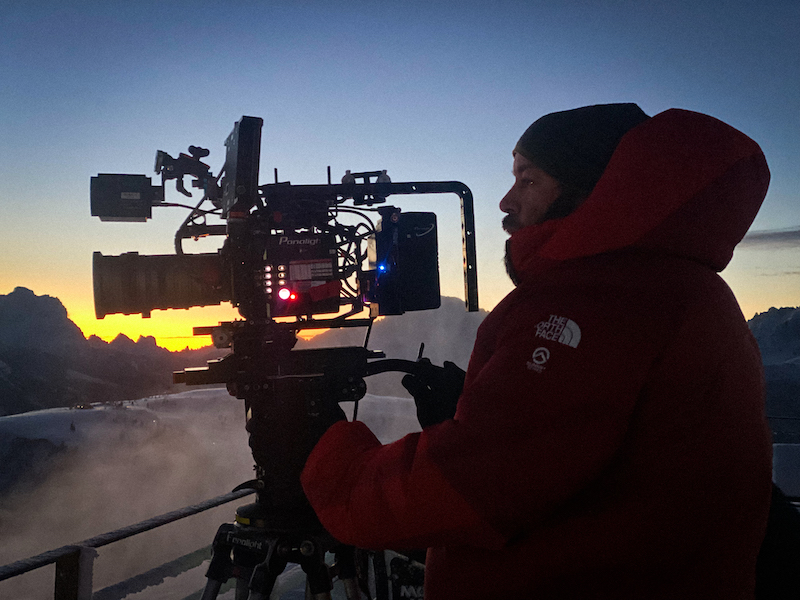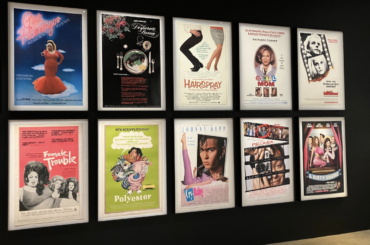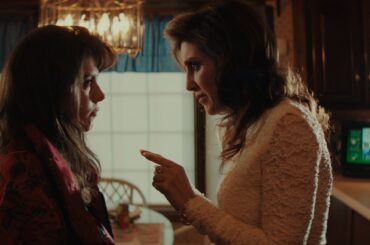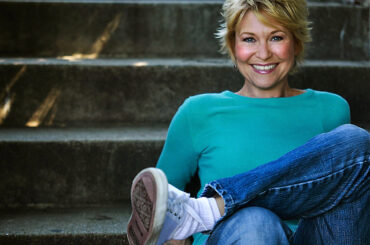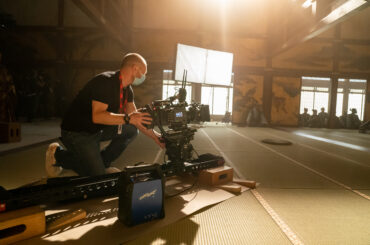Stephen Murphy BSC, ISC nails a variety of tones with Mr. & Mrs. Smith. In three episodes, the cinematographer paints a vivid portrait of a Bond-esque adventure on ski slopes and a marriage in decline in the woods. Murphy’s eye for action and intimacy is on full display in the excellent Amazon series, which was created by Francesca Sloane and Donald Glover.
Murphy previously worked with Glover on FX’s Atlanta. Once again, Murphy found the experience with the star and writer creatively fulfilling. “The thing I’m most proud of with Mr. & Mrs. Smith was the variety of scale and shooting styles we got to embrace across the season,” he told Immersive. “From shooting with extreme telephoto lenses on the streets of New York in a French Connection style, to night exteriors on New York rooftops with silky smooth Technocranes, to handheld Cassavetes style improv in the woods, all the way to the Italian Dolomites for a Bond-esque adventure. It was a fantastic project to touch on all of these things and yet it still feels very cohesive and driven in terms of its visual style.”
Recently, Murphy spoke with Immersive Media over email about his impressive work on the spy series, which is like an indie dramedy crossed with a globe-trotting adventure.
Episode Three: “First Vacation“
Was On Her Majesty’s Secret Service an inspiration for episode three?
When I started prepping the “First Vacation” episode with Karena [Evans] I did joke that this episode might be our best pitch for shooting a James Bond movie! Bond was something we all talked about as a reference throughout the series, primarily in the way the show travels to exotic locations, but when you set a thriller or spy story on the top of a snowy mountain in the Dolomites it’s hard not to compare it to Bond. The lovely thing about the tone of that episode is that it has a playfulness that’s reminiscent of the 60’s era Bonds, which I really enjoyed.
How did you find the camera responding to the snowy environment? How did you achieve the right lighting?
I had worked in heavy snow conditions beforehand briefly on another project so I was familiar with some of the technical challenges the extreme cold and high altitude would present to us. We talked about several solutions for camera movement, which ranged from airlifting a Technocrane to the top of the mountain to something much simpler like a ski sled.
Ultimately, what we used was a combination of a tank tread tracking vehicle from Panalight with a U-Crane arm on its roof which we used for the more dynamic moves, but for a large chunk of our work we used a Rig that my Italian grip Claudio del Gobbo built, which was a small speedrail dolly built on Skis, which carried a Black arm and a Ronin - that was incredibly effective as it meant we could “track in a linear fashion on the ice without needing to lay dolly track.
Lighting was also a challenge, but like with most day exteriors, I tried to plan the day and the coverage around the suns position during the day. We had a fantastic 1st AD, Doug Torres, and he was incredibly supportive of that way of working. For our interiors, we used a variety of Large Tungsten fixtures mixed with smaller LEDs, like Vortex 8’s for our closer work.
A huge amount of working in a harsh environment like this comes down to logistics and planning, because it’s not easy to move equipment at that elevation, so a lot of time in prep was spent with my gaffer, Cody Jacobs, and our Italian gaffer Elvis Pasqual about how to get the equipment up to the mountain and where we could stage from each day depending on which directions we would be looking. Carting equipment up the sides of the mountains in a fleet of Snowcats in predawn total darkness quickly became our normal day.
How did you and Karena want to create suspense? What did you both want and not want to do with the camera?
Karena talked a lot about presenting the surrounding world with a kind of stillness that reminded her of the movie Force Majeure, where the stillness added a subtle darker undertone that contrasted the visual beauty that surrounded us. Whenever we could we found those still life moments as interstitial pieces, or we would send our B Camera Operator Armando Avallone out to find a specific texture we had in mind.
There are some great, patient overhead shots. What were you aiming to accomplish with those overhead shots, and how did you achieve such a striking look? How was your experience with drone photography?
When it came to the fight sequence I suggested a long slow drone shot for that one beat at the beginning of the fight as a way for us to literally step back and see the world, see how high we were, and how small the characters were in it. We had a superb drone team who did an excellent job, but we did have to work quickly because the rotor blades would freeze after 4 minutes!
Both Karena and I were conscious of not defaulting into a normal episodic pattern of coverage, so we worked hard to find moments where the camera could breath, like the Slow Drone Shot at the top of the mountain or the shot inside the snowcat which slowly rotates and watches Donald’s character take out the guards one by one without cutting. It helps present the action in a more focused and considered way, and I think that helps build tension and draw the audience in.
The bathtub moment is pivotal for the series. What feelings did you and Karena want to evoke with that sequence?
Ending the sequence in the bathtub gave us the feeling of a much more intimate scene, giving us a chance to show the characters in a much more human light. We found a fantastic location, where all the bedrooms had exposed bathtubs set within the bedroom and that combination of a vulnerable, intimate scene set in a more open setting really helped visualize the strengthening of the lead characters’ growing relationship.
Episode Six and Seven: “Couples Therapy (Naked & Afraid)” & “Infidelity“
You spend a lot of time in the John and Jane’s home. Visually, how did you want to keep these spaces engaging? Any references there?
When I started my prep on the show in New York with director Amy Seimetz we talked with Hiro Murai and Christian Sprenger about the kinds of references they had discussed for their opening episodes. Amy and I talked about a lot of different influences but one we kept coming back to for Episode 6 and 7 was Ingmar Bergman’s “Scenes from a Marriage.”
What about portraying New York City and the woods? Any classic film references there?
We talked about a lot of New York set movies from the 70s, things like The French Connection, The Warriors, The Taking of Pelham 123, but we also talked about films like Alan Pakula’s Starting Over and even Friday the 13th Part 2 for the scenes in the woods. All of those references infused themselves into our choices of locations which in turn gave the episodes a lot of their flavor.
We were very keen to see parts of New York City that you don’t normally see on screen. We weren’t necessarily trying to show the picture postcard version of New York. The city is such a character, which changes from neighborhood to neighborhood, and that massively influenced how we shot but we didn’t want to have the Statue of Liberty in the back of every shot.
Showing the different missions during therapy, how did you want to differentiate them to reflect the state of their relationship?
The show is primarily about the growing relationship between the two characters so even though we shot episodes 6 and 7 before I shot episode 3 we were all conscious of how each episode needed to reflect a different stage in that relationship, and we tried to make visual choices to enhance that.
The argument in the woods is brutal. With so much drama in one scene, what do you consider your biggest job as a cinematographer?
Shooting in the woods in upper New York at night during a very hot summer was tricky but really enhanced the flavor of that brutal argument. Amy was really keen to try and shoot that in an unrehearsed way, using long takes, where the actors could improvise some of their dialogue and really respond to each other as the argument got more and more heated.
We had 2 cameras cross shooting, and I had to light the camp space to give the actors as much freedom as possible to move, while still keeping it moody and threatening. It worked really well, but it was such a brutal argument that I think we all felt like we needed to go home and hug our partners afterwards!
How did you aim to balance darkness and warmth in Bev’s (Michaela Coel) home? It’s inviting yet foreboding, especially once you learn the twist.
The fight sequence between Michaela Coel and the Smiths was also a little freestyle but with a different vibe. Again, we found an amazing location in that Brownstone, which really impressed myself and Amy, which was a little cavernous in a good way.
The further away the scene moved from the big bay windows, the darker it got and the more foreboding the scene became. The summer we shot in New York was incredibly hot so everyone’s skin naturally glistened and I embraced that. It was fantastic watching everyone’s skin take to the mix of cool and warm light in that space, enhanced by a lovely sheen.
How’d you pull off that fight sequence between John, Jane, and Bev?
Amy was keen to give the actors room to improvise within the space a little and I encouraged her to shoot the rehearsals once the Fight begins. I’ve used a method with fight scenes before where I’ll deliberately not show the operators the rehearsal so that they are then naturally responding to the fight blocking each time they see it. You can create some really fantastic, kinetic shots that way, and provided everyone supports the operators and the 1st AC’s and understands it won’t all be 100% perfect then it’s usually a really great way to shoot a fight scene like this.
We were able to squeeze 3 cameras into that brownstone for most of the fight which meant the actors and stunt teams could give it 100% physically each time and not have to worry too much about burning themselves out over the course of the day.
To light that way of shooting, I worked with gaffers Cody Jacobs and George Seldon and Key Grip Brendan Lowry to bounce a series of large HMI’s outside of the windows into a large eyebrow set just above the window line. The eyebrow helped keep the direct sun off the windows for most of the day and I could control the view outside the windows with nets. The HMI’s pushed soft cool light inside all day and then for the interiors we used a combination of practicals and Astera tubes wrapped in Lightsocks.
I also rigged some Litemats into the ceiling to extend the cool ambience from the HMIs’s. The lighting approach meant I could keep most of the larger units off the floor giving the actors and Operators maximum freedom to move and look wherever they needed.
Mr. & Mrs. Smith is now available to stream on Amazon Prime.


